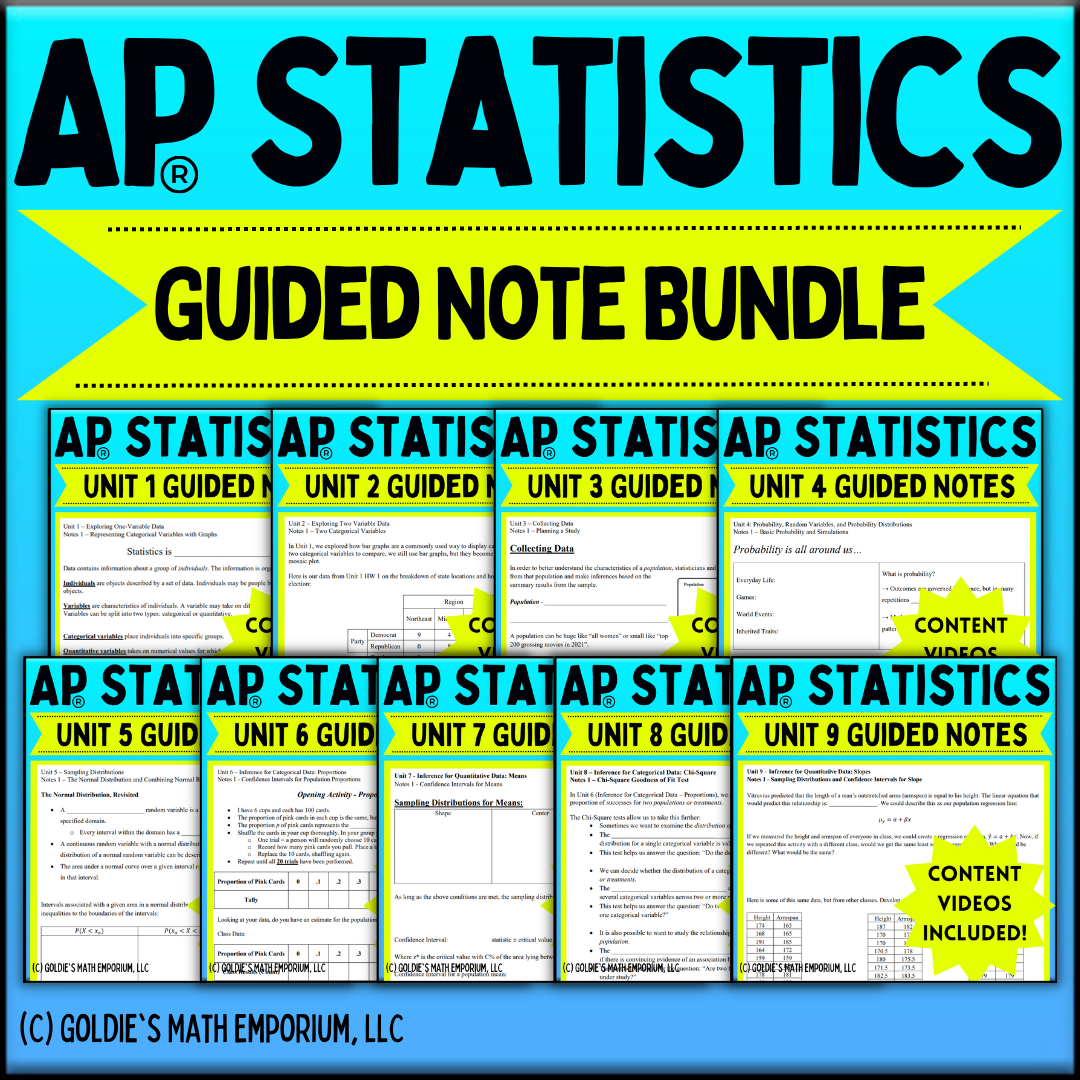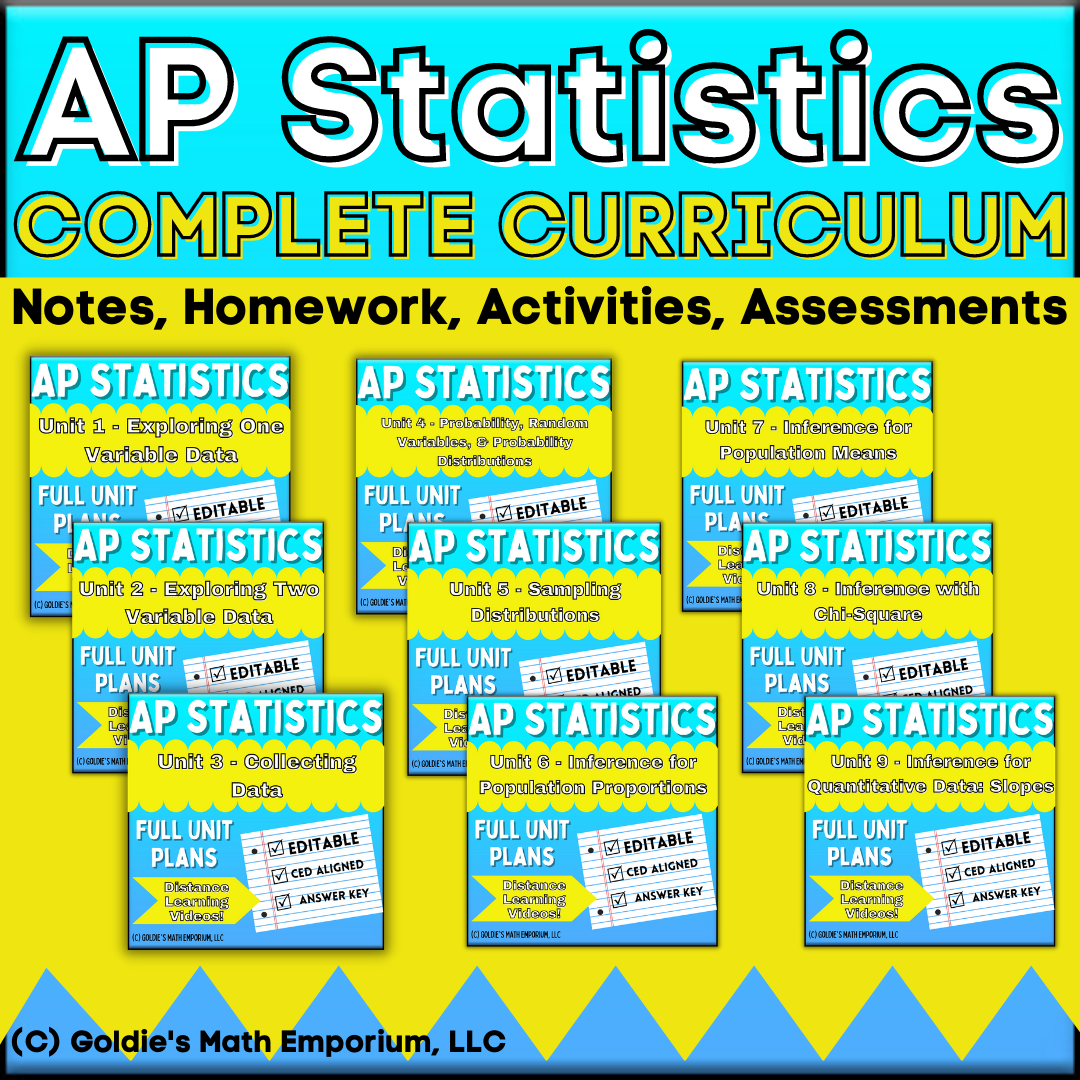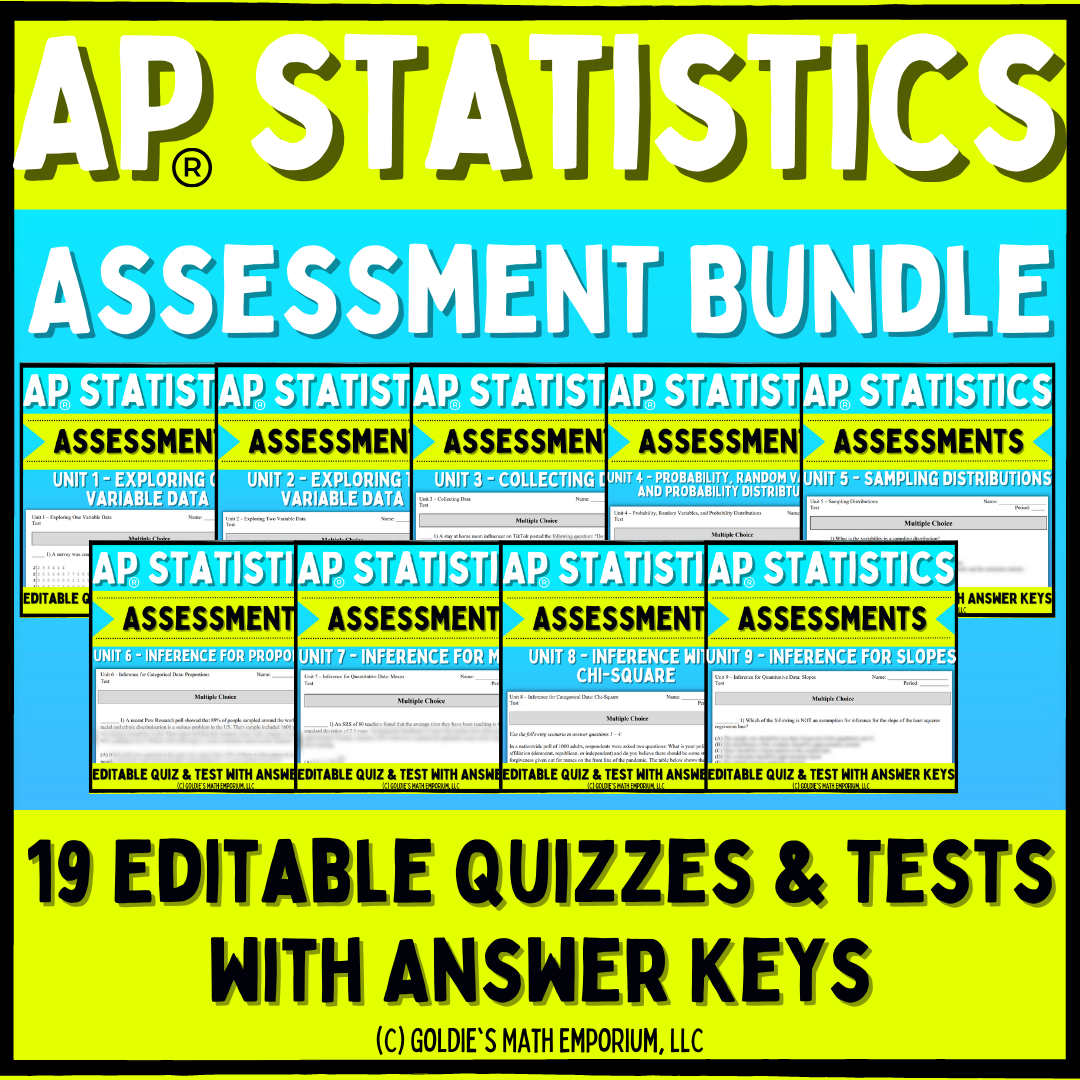Goldie’s AP© Statistics Full Curriculum FAQ
Welcome to my comprehensive guide on Goldie’s AP Statistics curriculum! If you’re looking to gain a deeper understanding of statistics while preparing for the challenging AP exam, you’ve come to the right place.
As a trusted provider of educational resources, Goldie’s curriculum is designed to equip students with the knowledge and skills needed to excel in the world of statistics. In this blog post, I’ll address the frequently asked questions surrounding Goldie’s AP Statistics curriculum, unraveling its unique features, benefits, and how it sets students on the path to success.
Let’s dive in and discover why Goldie’s AP Statistics curriculum stands out among the rest!

What is included in the full curriculum?
In this product, you will receive all of Goldie’s products related to AP® Statistics. All 9 units follow the College Board’s© CED and include the following:
Student Guided Notes: Student notes are “fill in the blank” style notes; teachers lead the lesson and work with students to complete the content. All content from the AP® CED is included and taught in the notes for this curriculum.
Content Videos: Each set of notes has a video to accompany it, where I teach the lesson so students can complete the notes. These are great for a flipped classroom, assigning notes as homework, or absent students.
Homework Assignments: There is a homework assignment with each set of notes, that allows the students to practice what they learned in the notes.
Unit Class Summaries: Each unit contains a summary lesson that comes with teacher PowerPoint slides and a student handout that reviews all the material we learned in the unit.
Assessments: Each unit comes with a quiz and a test with AP® style multiple choice questions and a free response problem, to assess student understanding.
Unit Projects: There is at least one unit project in each unit, where students are asked to apply what they have learned in a unit to a project.
Classroom Activities: There are multiple classroom activities in each unit, where students can learn and explore content outside of the traditional note setting.
Also Included:
- 1st Semester Final Exam and Study Guide
- 2nd Semester AP® Exam Review Materials
- 2nd Semester AP® Exam Projects
Bonus Files:
- 2023/24 AP® Approved Syllabus
- 2023/24 Year Pacing Calendar
- First Two Days in AP® Statistics
- AP® Statistics Exam Crunch Sheet
- Binder Covers
- Content Video Document
All of the resources are 100% editable, so you are able to modify them to fit your classroom needs. The zip folder includes all the Word documents for the resources, which you have permission to edit. The PDF version and answer keys are included for your convenience.
I teach this course without a textbook, so everything that is provided here, can be used without supplementation. The only thing I use in my class that is NOT included in this content is the secured AP® exam questions.
Does this curriculum follow a specific textbook?
This curriculum was designed to follow the AP Statistics Course and Exam Description. If a textbook also follows the CED, my curriculum will follow it. You do not need to adopt a specific textbook to use my curriculum. Remember that your students do need access to an AP-level textbook for the course, so you will still need a textbook. At my previous school, all students in the school had an online portal through a popular publisher that granted them access to a college-level statistics textbook.
Can I use this curriculum for a non-AP course or a college-level course?
Absolutely! I have had quite a few teachers who have successfully transformed this curriculum to meet their class needs, which include modifying the material to a non-AP course and a college-level course.
How do you set up your grade book?
At my most recent school, we had to (as a math department) have 70% of our students’ grades be based on summative assessments, and 30% of their grade based on formative assessments. I made each unit test 50 points, and those made up 70% of the student’s grade. For formatives, I made each individual homework assignment 10 points, each activity 10 points, each quiz 50 points (I dropped the lowest quiz score at the end of the semester), and each unit project anywhere between 30-50 points, depending on how much time I felt would go into it (some unit projects are longer than others).
Do you have pacing for a block schedule?
I do! Here is a Word document that you can have FOR FREE to check out how I pace this course in a block schedule. My yearly pacing schedule is based on 50-minute, everyday class periods. You can also get this pacing document for free here.
What do you do for bell ringers or exit slips in the course?
For bell ringers, it will depend on the day! Some days, I find a good MCQ from the AP classroom (secured, past exam questions) that pertain to the material we learned the day before. I informally tell students to get an answer before class starts, and then we go over the answer. Some days, I will ask if there were any questions from last night’s homework, and we will go over a problem or two. The day after I grade quizzes, I usually go over some of the most missed quiz questions after I pass them back. Then there are the occasional days where I honestly just jump right into the notes or activity! I usually don’t have time to do exit slips; we are either working on the notes and activities right up to the bell, or I have students working on homework assignments at the end of class.
How much time do you give students for the quizzes?
For each quiz, I give the full class period (about 50 minutes) but most students complete it between 30 and 40 minutes.
How much time do you give students for the tests?
For each test, I give the full class period, but about half will finish in 50 minutes and the other half will usually need to come in after school to finish it. At least this is the case from Units 1 to Unit 3. By Unit 4, most students get better at timing themselves on the MCQs and can move through and finish a little quicker.
What do you allow students to use on the quizzes and tests?
I allow a calculator and the AP formula sheet for all assessments (quizzes and tests) so they can get used to those tools.
How do you grade your tests?
At my most recent school, we graded with a point system. In the grade book, each test is worth 50 points, but each test will have various amounts of points, so I find the total number of points on the test, and calculate the student’s grade based on the following formula:
% grade = (50 – points missed)/50
This will give a little bit of a “buffer” in terms of grading and will allow for slightly inflated grades. Between this and the fact that I allow reassessments (see the next section for how I do those), I do not curve test grades.
For example, Unit 1 has 20 multiple-choice and 1 free-response question (3 parts). I make every multiple-choice question 1 point each and then for the free response, I did 3 points for part (a), 3 points for part (b), and 2 points for part (c)). This brings the total test amount to 28 points.
Missing 3 points would be: (50 – 3)/50 = 94%
Any other questions?
Comment below if you have any other questions about this curriculum! I love helping teachers and want to be here with anything you need.



Do you use your curriculum in conjunction with AP Classroom? If so, is it well aligned for assigning material on the website alongside your material?
Hello!! Great question, it is aligned with the AP Statistics CED, so it pairs very well with the AP Classroom and assigning materials from there.